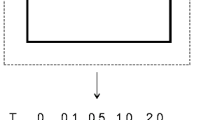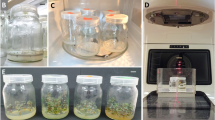Summary
In previous publications, we reported that sinusoidal varying magnetic fields (SVMF) modify the activity and dynamics of the malignancy marker adenosine deaminase, and enhance the proliferation of chick embryo fibroblasts (CEF). While the SVMF examined by us (50, 60 & 100 Hz / 0.06–0.7 mT) were all below kT, they may have the potential of altering chemical processes in which excited radicals are involved.
We tested this hypothesis in two experimental systems: CEF in culture and Spirodela oligorrhiza (Lemnaceae) (a small aquatic plant, commonly known as Duckweed). CEF were exposed to SVMF of 100 Hz/0.7 mT for 24 h. The addition of the exogenous radical scavengers catalase, superoxide dismutase or vitamin E to the cells during exposure significantly suppressed enhancement of cell proliferation caused by the field (by 79, 67 and 82%, respectively, as evaluated by the MTT colorimetric assay). 15N NMR analysis of Duckweed plants fed by 15N-labeled ammonium chloride and exposed to SVMF at 60 and 100 Hz/0.7 mT for 24 h, revealed augmented alanine production. Alanine did not accumulate in the absence of SVMF. The addition of vitamin C, a radical scavenger, reduced alanine production by 82%.
Exposure to SVMF resulted in specific metabolic stress effects in Duckweed plants and enhanced proliferation of CEF. In both cases, it is suggested that free radicals are involved.
Similar content being viewed by others
Abbreviations
- SVMF:
-
sinusoidal varying magnetic fields
- CEF:
-
chick embryo fibroblasts
- ADA:
-
adenosine deaminase
- SOD:
-
superodxide dismutase
References
Adair, B.K.: 2000, “Static and Low-Frequency Magnetic Field Affects Health, Risks and Therapies,” Rep. Prog. Phys. 63, 415–454.
Ben-Shooshan, I., Kessel, A., Ben-Tal, N., Cohen-Luria, R., Parola, A.H.: 2002, “On the Regulatory Role of Dipeptidyl Peptidase IV (= CD26 = Adenosine Deaminase Complexing Protein) on Adenosine Deaminase Activity,” Biochim. Biophys. Acta. 1587, 21–30.
Ben-Izhak Monselise, E., Parola, A.H. and Kost, D.: 2003, “Low-Frequency Electromagnetic Fields Induce a Stress Effect upon Higher Plants, as Evident by the Universal Stress Signal, Alanine,” Biochem. Biophys. Res. Commun. 302, 427–434.
Ben-Izhak Monselise, E. and Kost, D.: 1998, “15N-NMR Spectroscopic Study of Ammonium Ion Assimilation by Spirodela Oligorrhiza Lemnaceae,” as affected by light and carbon supply in green and etiolated plants. IsraeI J. Plant Sci. 46, 255–264.
Blank, M. and Goodman, R.: 2002, “Insights into Electromagnetic Interaction Mechanisms,” J. Cell. Physiol. 192, 16–22.
Brandes, R.P. and Kreuzer, J.: 2005, “Vascular NADPH Oxidases: Molecular Mechanisms of Activation,” Cardiovasc. Res. 65, 16–27.
Cheeseman, K.H. and Slater, T.F.: 1993, “An Introduction to Free Radical Biochemistry,” Br. Med. Bull. 49, 481–493.
Cohen, S.G., Parola, A.H. and Parsons, G.H.: 1973, “Photoreduction by Amines,” Chem. Rev. 73, 141–161.
Duchen, M.R.: 2004, “Mitochondria in Health and Disease: Perspectives on a New Mitochondrial Biology,” Molec. Aspects Med. 25, 365–451.
Antov, Y., Barbul, A. and Korenstein, R.: 2004, “Electroendocytosis: Stimulation of Adsorptive and Fluid-Phase Uptake by Pulsed Low Electric Fields.” Exp. Cell Res. 297, 348–62.
Ferrari, R., Merli, E., Cicchitelli, G., Mele, D., Fucili, A. and Ceconi, C.: 2004, “Therapeutic Effects of L-Carnitine and Propionyl-L-Carnitine on Cardiovascular Diseases: A Review,” Ann. N. Y. Acad. Sci. 1033, 79–91.
Grissom, C.B.: 1995, “Magnetic Field Effects in Biology: A Survey of Possible Mechanisms with Emphasis on Radical-Pair Recombination,” Chem. Rev. 95, 3–24.
Gutzeit, H.O.: 2001, “Biological Effects of ELF-EMF Enhanced Stress Response: New Insights and New Question,” Electro- Magnetobiol. 20, 15–26.
Guyton, K.Z. and Kensler, T.W.: 1993, “Oxidative Mechanisms in Carcinogenesis,” Br. Med. Bull. 49, 523–544.
Haddad, J.J.: 2004, “On the Antioxidant Mechanisms of Bcl-2: A Retrospective of NF-κ B Signaling and Oxidative Stress,” Biochem. Biophys. Res. Commun. 322, 355–363.
Hileman, B.: 1993, “Health Effects of Electromagnetic Fields,” Chem. Eng. News 71, 15–29.
Jeong, J.H., Kim, J.S., Lee, B.C., Min, Y.S., Kim, D.S., Ryu, J.S., Soh, K.S., Seo, K.M. and Sohn, U.D.: 2005, “Influence of Exposure to Electromagnetic Field on the Cardiovascular System,” Auton Autacoid Pharmacol. 25, 17–23.
Katsir, G. and Parola, A.H.: 1998, “Enhanced Proliferation Caused by a Low Frequency Weak Magnetic Field in Chick Embryo Fibroblasts is Suppressed by Radical Scavengers,” Biochm. Biophys. Res. Commu. 252, 753–756.
Katsir, G., Baram, S.C. and Parola, A.H.: 1998, “Effect of Sinusoidally Varying Magnetic Fields on Cell Proliferation and Adenosine Deaminase Specific Activity,” Bioelectromagnetics 19, 46–52.
Koppitz, H., Dewender, M., Ostendorp, W. and Schmieder, K.: 2004, “Amino Acids as Indicators of Physiological Stress in Common Reed Phragmites Australis Affected by an Extreme Flood,” Aquatic Botany 79, 277–294.
Kleinerman, R.A., Linet, M.S., Hatch, E.E., Tarone, R.E., Black, P.M., Selker, R.G., Shapiro, W.R., Fine, H.A. and Inskip, P.D.: 2005, “Self-Reported Electrical Appliance Use and Risk of Adult Brain Tumors,” Am. J. Epidemiol. 161, 136–146.
Lin, H., Opler, M., Blank, M. and Goodman, R.: 1997, “Electromagnetic Field Exposure Induces Rapid, Transitory Heat Shock Factor Activation in Human Cells,” J. Cell. Biochem. 66, 482–488.
Lacy-Hulbert, A., Metcalfe, J.C. and Hesketh, R. 1998, “Biological Responses to Electromagnetic Fields,” FASEB J. 12, 395–420.
Liboff, A.R. and Jenrow, K.A.: 2000, “Cell Sensitivity to Magnetic Fields,” Electro- Magnetobiol. 19, 223–236.
Lander, H.M.: 1997, “An Essential Role for Free Radicals and Derived Species in Signal Transduction,” FASEB J. 11, 118–124.
Liberto, C.M., Albrecht, P.J., Herx, L.M., Yong, V.W. and Levison, S.W.: 2004, “Pro-Regenerative Properties of Cytokine-Activated Astrocytes,” J. Neurochem. 89, 1092–1100.
Markov, M.S.: 1994, “Biophysical Estimation of the Environmental Importance of Electromagnetic Fields,” Rev. Environ. Health 10, 75–83.
Mohtat, N., Cozens, F.L., Hancock-Chen, T., Scaiano, J.C., McLean, J. and Kim, J.: 1998, “Magnetic Field Effects on the Behavior of Radicals in Protein and DNA Environments,” Photochem. Photobiol. 67, 111–118.
Mayr, M., Metzler, B., Chung, YL., McGregor, E., Mayr, U., Troy, H., Hu, Y., Leitges, M., Pachinger, O., Griffiths, JR., Dunn, M.J. and Xu, Q.: 2004, “Ischemic Preconditioning Exaggerates Cardiac Damage in PKC-δ Null Mice,” Am. J. Physiol. Heart Circ. Physiol. 287, H946–H956.
Mosmann, T.: 1983, “Rapid Colorimetric Assay for Cellular Growth and Survival: Application to Proliferation and Cytotoxicity Assays,” J. Immunol. Methods 65, 55–63.
Minotti, G., Menna, P., Salvatorelli, E., Cairo, G. and Gianni, L.: 2004, “Anthracyclines: Molecular Advances and Pharmacologic Developments in Antitumor Activity and Cardiotoxicity,” Pharmacol. Rev. 56, 185–229.
Mahrour, N., Pologea-Moraru, R., Moisescu, M.G., Orlowski, S., Leveque, P. and Mir, L.M.: 2005, “In vitro Increase of the Fluid-Phase Endocytosis Induced by Pulsed Radiofrequency Electromagnetic Fields: Importance of the Electric Field Component,” Biochim. Biophys. Acta. 1668, 126–37.
Nissim, I.T., Hardy, M., Pleasure, J., Nisim, I.L. and States, B.A.: 1992, “A Mechanism of Glycine and Alanine Cytoprotective Action: Stimulaion of Stress-Induced HSP70 mRNA,” Kidney Int. 42, 775–782.
Parola, A.H. and Markel, A.: 1994, “Biological Effects of Electric and Magnetic Fields,” in: D.O. Carpenter and S. Ayrapetyan (eds.), “Electric and Magnetic Fields and Carcinogenesis,” Academic Press, Vol. 2, pp. 177–197.
Pipkin, J.L., Hinson, W.G., Youngm, J.F., Rowland, K.L., Shaddock, P.J., Tolleson, W.H., Duffy, P.H. and Casciano, D.A.: 1999, “Induction of Stress Proteins by Electromagnetic Fields in Cultured HL-60 Cells,” Bioelectromagnetics 20, 347–357.
Parola, A.H., Caiolfa, V.R., Ben-Shooshan, I. and Cohen-Luria, R.: 2000, “The Regulatory Role of Adenosine Deaminase Complexing Protein (Dipeptidyl Peptidase IV = CD26) on the Malignancy Marker Adenosine Deaminase: Effect of Membrane Cholesterol and Phase—Transition,” Drug Develop. Res. 50, 537–549.
Porat, N., Gill, D. and Parola, A.H.: 1988, “Adenosine Deaminase in Cell Transformation. Biophysical Manifestation of Membrane Dynamics,” J. Biol. Chem. 263, 14608–14611.
Parola, A.H., Porat, N. and Kiesow, L.A.: 1993, “Chicken Embryo Fibroblasts Exposed to Weak, Time-Varying Magnetic Fields Share Cell Proliferation, Adenosine Deaminase Activity, and Membrane Characteristics of Transformed Cells,” Bioelectromagnetics 14, 215–228.
Portaccio, M., De Luca, P., Durante, D., Grano, V., Rossi, S., Bencivenga, U., Lepore, M. and Mita, D.G.: 2005, “Modulation of the Catalytic Activity of Free and Immobilized Peroxidase by Extremely Low Frequency Electromagnetic Fields: Dependence on Frequency,” Bioelectromagnetics 26, 145–152.
Ramundo-Orlando, A., Serafino, A., Schiavo, R., Liberti, M. and d'Inzeo, G.: 2005, “Permeability Changes of Connexin32 Hemi Channels Reconstituted in Liposomes Induced by Extremely Low Frequency, Low Amplitude Magnetic Fields,” Biochim. Biophys. Acta. 1668, 33–40.
Scaiano, J.C., Cozens, F.L. and McLean, J.: 1994, “Model of the Rationalization of Magnetic Field Effects in vivo. Application of Radical-Pair Mechanism to Biological Systems,” Photochem. Photobiol. 59, 585–589.
Scaiano, J.C., Mohtat, N., Cozens, F.L., McLean, J. and Thansandote, A.: 1994, “Application of the Radical Pair Mechanism to Free Radicals in Organized Systems: Can the Effects of 60 Hz be Predicted from Studies under Static Fields?” Bioelectromagnetics 15, 549–554.
Saxena, A., Jacobson, J., Yamanashi, W., Scherlag, B., Lamberth, J. and Saxena, B.: 2003, “A Hypothetical Mathematical Construct Explaining the Mechanism of Biological Amplification in an Experimental Model Utilizing PicoTesla (PT) Electromagnetic Fields,” Med. Hypotheses 60, 821–39.
Turro, N.J. and Weed, G.C.: 1983, “Micellar Systems as Supercages for Reactions of Geminate Radical Pairs. Magnetic effects,” J. Am. Chem. Soc. 105, 1861–1868.
Turro, N.J., Buchachenko, A.L. and Tarasov, V.F.: 1995, “How Spin Stereochemistry Severely Complicates the Formation of a Carbon-Carbon Bond Between two Reactive Radicals in a Supercage.” Acc. Chem. Res. 28, 69–80.
Turro, N.J.: 1996, “Supramolecular Photochemistry,” A paradigm for the 1990's? J. Photochem. Photobiol. A: Chem. 100, 53–56.
Author information
Authors and Affiliations
Corresponding author
Rights and permissions
About this article
Cite this article
Parola, A.H., Kost, D., Katsir, G. et al. Radical Scavengers Suppress Low Frequency EMF Enhanced Proliferation in Cultured Cells and Stress Effects in Higher Plants. Environmentalist 25, 103–111 (2005). https://doi.org/10.1007/s10669-005-4272-z
Issue Date:
DOI: https://doi.org/10.1007/s10669-005-4272-z




